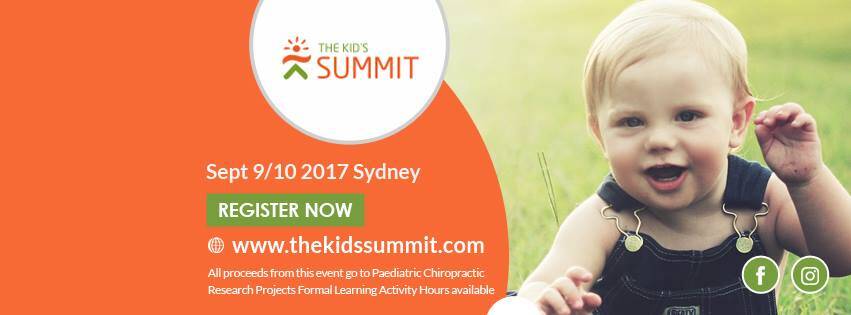Learn about new research into chiropractic care for kids with ASD, ADHD and cerebral palsy funded by The Kid’s Summit
The Chiropractic Board of Australia recently released its positioning statement on paediatric care (1). This statement highlights the importance of chiropractors having specialised knowledge and skills when it comes to caring for children as distinct from adults, as well as having high level research supporting chiropractic care for kids. These points are essential when it comes to safety of the people we serve, and is what we are focusing on at the Kid’s Summit on September 9 & 10 in Sydney, NSW.
The purpose of The Kid’s Summit is to:
- Further chiropractic education in caring for children,
- Create an environment of support and collaboration among chiropractors seeing kids,
- Raise funds for research into chiropractic care for kids.
All proceeds from The Kid’s Summit go straight to research
Our world-class speakers pay their own expenses and are not remunerated in any way. They come to share their knowledge and their passion and to help raise funds for research! Based on this model, we have been able to raise almost $80,000 and with that make a significant contribution to research into chiropractic care for children. We are currently helping fund the following three projects at The Centre for Chiropractic Research at New Zealand Chiropractic College:
Effects of chiropractic care on sensorimotor and multisensory integration in children with ASD
Aisha Strand’s pilot study investigates the effects of chiropractic care on sensorimotor and multisensory integration in children with Autism Spectrum Disorder (ASD). Children with ASD have clear social interaction, behavioural and communication issues. However, they often also exhibit dysfunctional motor learning and control, such as poor balance, dyspraxia, poor handwriting skills, clumsiness and delay in reaching motor milestones. Interestingly, there seems to be an association between the level of motor dysfunction and the severity of social interaction issues, with greater levels of motor dysfunction being associated with poorer skills in social interaction. Some suggest that these motor control impairments seen in ASD may be a result of disrupted sensorimotor integration and abnormal multisensory integration. In her study, Aisha will investigate whether chiropractic care improves sensorimotor integration and multisensory integration in children with autism. The outcome measures in this study will be assessing how the brain integrates light and sound, proprioception, bilateral manual co-ordination (diadochokinesia), fine motor skills, and the ability to localise tactile stimuli. As this is a pilot study it will be assessing the effects of a single adjustment session. The results will then be used to help plan a full-scale clinical trial later down the track assessing the effects of chiropractic care over a longer period of time.
Effects of chiropractic care on ADHD and eye movements
Alice Cade is doing a project looking at Attention deficit hyperactivity disorder (ADHD) and eye movements. ADHD is a disorder that affects academic performance, social interactions, and interpersonal relationships amongst others. It is characterised by impulsiveness, hyperactivity, and inattention. Affected individuals often continue to show significant symptoms of the disorder as adults and may have associated difficulties such as lower educational and employment achievement. Children who suffer from ADHD have been known to have poor oculomotor control, which affects their ability to read efficiently. The result is disordered sensorimotor processing. This dysfunctional oculomotor control may be due to changes in the prefrontal cortex, which affects decision making associated with eye movement. Chiropractic care has been shown to affect prefrontal cortex activity and sensorimotor processing as well as proprioceptive/vestibular function. In her study, Alice will be assessing 30 children with ADHD between 8 and 15 years of age. The experimental group will receive a single session of chiropractic care, while the active control group will receive spinal range of motion and body movements. The aim is to see whether a single session of chiropractic care can alter oculomotor function in children with ADHD. When she has finished her Master’s degree, Alice plans to continue this line of research in a PhD programme.
Effects of chiropractic care on children with cerebral palsy
Jenna Duehr’s research project will look at the effects of a single session of chiropractic care on muscle strength and neuromuscular control in children with cerebral palsy (CP). Chiropractic adjustments have been shown to increase muscle strength in healthy adults and alter cortical drive and motor neuron excitability. A study assessing modulation of the H reflex during gait in children with CP suggested that children with CP have an abnormal H reflex in the stance phase. This is interesting because the research team at the NZCC recently showed that chiropractic adjustments lead to neural changes in cortical drive and the H-reflex pathway in a normal, healthy people. It is therefore possible that chiropractic adjustments will result in similar changes in children with CP.
These are exciting studies that will help our profession provide the best possible care for the people we serve as well as better understand the science behind what we do. This is definitely something you will want to know more about.
Please join the movement to further chiropractic care for kids and register and attend The Kid’s Summit in Sydney on September 9 & 10, 2017.
Reference:
1. http://www.chiropracticboard.gov.au/Codes-guidelines/FAQ/Position-statements/Paediatric-care.aspx



